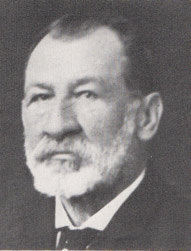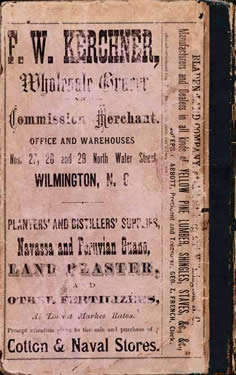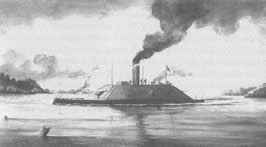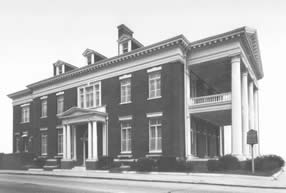
Mission Statement:
"To advance through research, education and symposia, an increased public awareness of the Cape Fear region's unique history."

Colonel F.W. Kerchner
Harper's Ferry Veteran, Wilmington Merchant

Cape Fear Historical Institute Papers
The Old Wilmington Guidebook identifies the home at
416 South Front Street as being originally built in 1821
by William B. Meares on the site of the current post office
at Chestnut and Front Streets:
“moved c. 1887 by F.W. Kerchner,
prominent wholesale grocer and wine dealer,
who added the third story, and molded-metal window
ding Corinthian columns. The rear garden has a long
river vista, framed by tall urns, and a very
old Soulangeana magnolia that is covered
with pale pink blossoms in February.”
416 South Front Street Today
The Wilmington Messenger wrote on 7 April 1888 that
“Col. F.W. Kerchner’s new residence on South Front street,
rebuilt out of the old Bridger’s building, will be quite an addition
to that part of the city.” Kerchner purchased the home from
Edward and Margaret Bridgers, who sold their property
to the US government for a new post office but reserving the
right to remove the home built upon the land. This home was
built by noted contractor of that period, Robert B. Wood.
Not a native Wilmingtonian, Francis William Kerchner
was born 29 January 1829 at Freudenburg, then a small town
on the Main River in the Grand Duchy of Baden. He was
the son of Michael Anthony and Anna Maria (Kern) Kerchner,
all who arrived in Philadelphia aboard the passenger ship
Adler from Bremen on 6 September 1832.
Though the family originally settled in Philadelphia after
arrival, a move was made to Baltimore where Francis
grew into manhood. By age 26, he is found in Baltimore’s
Matchett’s Directory of 1855-56 as a
“Fashionable Boot & Shoe Maker” with a shop located at
169 West Fayette Street in that city. His establishment
Skin Boots and Shoes of all descriptions,
Wholesale and Retail.”
Kerchner married Lydia Catherine Hatch (1834-1894)
about 1855 in Baltimore, where he had become a successful
merchant and local militia officer. At the time of John Brown’s
October 1859 insurrection at Harper’s Ferry arsenal in Virginia,
Lieutenant Kerchner was reported as being in command of
a Maryland militia company which assisted Virginia militia
and US Marines under the command of Lt. Col. Robert E. Lee
in capturing Brown and his cohorts. Also present and under
Lee’s command was Lieutenant J.E.B. Stuart.

Kerchner, probably along with Lt. Stuart, searched
a nearby farmhouse which had been rented by Brown,
seizing Sharps carbines, revolvers and papers, the latter
of which were turned over to Virginia Governor Henry A. Wise,
to be used in Brown’s prosecution. These papers were letters
and donation receipts from wealthy Northern supporters and
abolitionists, including Gerrit smith, George Stearns,
Thomas Higginson, Theodore Parker, Joshua Giddings
and Frederick Douglas who had encouraged Brown to
initiate race war in the American South.
After Brown’s capture, many of his Northern supporters
either feigned illness or went into hiding to avoid prosecution
for treason against Virginia by Governor Wise; Frederick
Douglas fled to Canada as soon as news of the Harper’s
Ferry insurrection appeared as deeply incriminating letters
were found in Brown’s carpetbag.
Immediately after Brown’s capture, Lt. Stuart said of him:
“This is the celebrated John Brown of Kansas notoriety, a man
so infamous for his robberies and murders that if people here
knew his antecedents he would not be permitted to live five minutes.”
Apparently maintaining contact with his prewar Maryland militia
comrades, the 17 October 1899 Wilmington Dispatch reported
that “Col. F.W. Kerchner will leave here tonight for Baltimore
to attend a reunion of the survivors of the Harper’s Ferry raid
in 1859. The reunion will be held tomorrow which is the
anniversary of John Brown’s surrender. Col. Kerchner was
in command of the company that effected Brown’s capture.”
Kerchner came to Wilmington in 1865 with the Wilmington
Chamber of Commerce noting that he started “in the wholesale
grocery and cotton and commission business just
after the close of the war.”
His first partnership was Keith & Kerchner, wholesale grocers
and agents for a Baltimore packet boat line, and in 1874 he
organized the firm of Kerchner & Calder Bros. This partnership
continued to 1886, at which time he became sole proprietor.
The Kerchner & Calder enterprise apparently included
a cabinetry shop located at 305 South Second Street,
which is depicted on Gray’s map of 1881 Wilmington.
Haddock’s 1871 Wilmington Directory lists F.W. Kerchner
as a director of the Wilmington Life Insurance Company along
with T.H. McKoy; former Wilmington Mayor John Dawson is
Vice President and Stephen D. Wallace, Treasurer.
Wallace had been elected president of the
Wilmington & Weldon Railroad in 1862 and the
Duplin County town of Wallace, formerly
Duplin Roads, is named for him.
Kerchner’s business advertisement is found on the directory’s
back cover, and shows his primary business location at
“27, 28 and 29 North Water Street.”

Another of his commercial ventures was the O.F. Love & Company hardware store, and a naval stores enterprise centered on what is
now Chandler’s Wharf and Elijah’s Restaurant on North Water Street.

Kerchner’s wartime military experience is little known, though
the 1889 roster of the Cape Fear Camp, No. 254
United Confederate Veterans, credits him to the
Second Maryland Regiment from which his military title
of “Colonel” apparently emanates.
Some of Col. Kerchner’s comrades of in that 1889 Camp
were Col. John Douglas Taylor, Camp Commander;
Col. William Lord DeRosset; Major Charles Pattison Bolles;
Col. James G. Burr; Col. John Lucas Cantwell;
Major Graham Daves; Corp. Junius Davis; Col. Edward D. Hall;
Lt. Col. Oliver P. Meares; Lt. Col. Roger Moore;
Major Charles McClammy; Major T. Hall McKoy;
Captain Henry Savage; Major Charles Stedman;
and Capt. Stacey Van Amringe.
Col. Kerchner was an investor in the Navassa Guano Company,
chartered on August 5, 1869 and located at Meare’s Bluff
on the northwest branch of the Cape Fear River and about five miles
from Wilmington. The factory produced chemicals
and fertilizer and was conveniently situated near the railroad;
by the latter 1880’s it had become highly profitable and
a steady employer of Wilmingtonians.
Governor Dudley Mansion
Upon moving to Wilmington, F.W. and wife Lydia acquired
the Governor Dudley mansion at 400 South Front Street
(built in 1825 by North Carolina's firsr elected governor,
Edward B. Dudley), where they lived from
1871 to about 1890;
the mansion was purchased by wealthy rice planter and
financier Pembroke Jones. Captain Pembroke Jones commanded
the Cassidy Boatyard-built ironclad CSS Raleigh, an vital
part of Wilmington’s wartime defenses in 1864.

Ironclad CSS Raleigh
Along with several of his military comrades and prominent
businessmen of Wilmington, Kerchner was a early member
of the prestigious Cape Fear Club, and served in 1868 as
a member of its Governing Committee. At that time the Club
was meeting on Front Street between Market and Princess Streets;
in 1885 it had moved to the second floor of the Bank of New
Hanover building, corner of Princess and Front Streets. Since
1913, the Club has resided at the corner of Second
and Chestnut Streets.

The Cape Fear Club
A well-respected businessman and city leader, the 1892
“Cyclopedia of Eminent and Representative Men of the
Carolinas of the Nineteenth Century” said of him:
“Col. F.W. Kerchner occupies a prominent position here
as promoting most materially the mercantile importance
of this city and port. [He] is the efficient and enthusiastic
president of the chamber of commerce, which position he
holds with honor and credit to himself, and the
satisfaction of the community.
He was formerly a citizen of Baltimore, but since his adoption
of this city as his home, in 1865, he has always been alive
to her interests and contributed materially to her progress
and advancement, assisting with brains and means to elevate
all worthy industries, animating others to
by his example and efforts.
He was an ardent supporter of the cause of the South
during our Civil war, and he gave liberally of his time and
his means to insure its success, and frequently at great
personal risk to himself. There are few men better known
in the State than F.W. Kerchner, his genial manner and
generous impulses have made him troops of friends and he
has a faculty, a very happy one it is too, of retaining
friendships when once formed. He is now in the vigor of life
and with every prospect for a long and useful career.”
It is recorded that Lydia Kerchner died in 1894, probably
in Wilmington; F.W. Kerchner died April 2, 1910 at Hamilton,
Maryland, an old farming suburb of Baltimore which may have
been the family homestead.
Sources:
Old Wilmington Guidebook, Junior League of Wilmington
Descendant Chart for Michael Anthony Kerchner, www.kerchner.com/des1608.htm. CDR C.F. Kerchner, (Ret.).
Archives of Maryland, Matchett’s Baltimore Directory for 1855-56
The Secret Six, John Brown, Otto Scott, Uncommon Books, 1979
Wilmington, an Architectural Portrait, Wrenn, U. Press of Virginia, 1984
©2006 Cape Fear Historical Institute